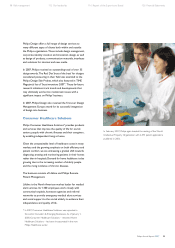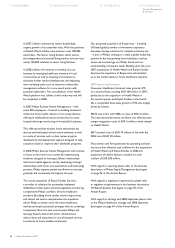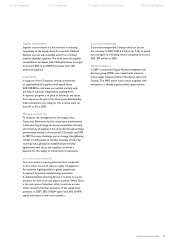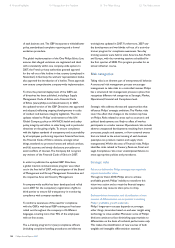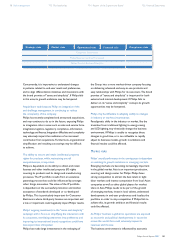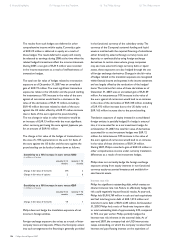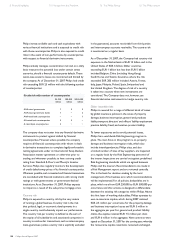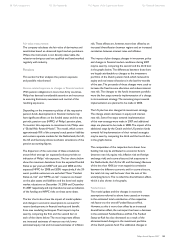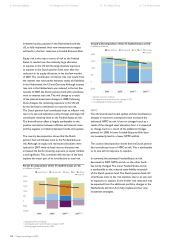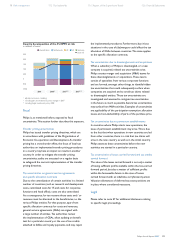Philips 2007 Annual Report Download - page 96
Download and view the complete annual report
Please find page 96 of the 2007 Philips annual report below. You can navigate through the pages in the report by either clicking on the pages listed below, or by using the keyword search tool below to find specific information within the annual report.
Philips Annual Report 2007102
and political uncertainties that continue to affect the
global economy and the international capital markets.
Economic and political developments could have a material
adverse effect on Philips’ operating results. For example,
the crisis that began in the US nancial markets in the
second half of 2007 has negatively impacted consumer
borrowing and spending, and has exposed the cyclical
commercial construction sector on which growth in the
luminaires industry is strongly dependent.
Philips is exposed to markets with high complexity,
and is facing continued competition.
Philips continually faces competitive challenges such
as speed of innovation, fast-moving market trends, rapid
technological change, evolving standards, shortening product
life cycles, the cyclical nature of certain sectors and price
erosion. Earnings improvement is highly exposed to these
increased competitive challenges, which requires margin
management through measures such as price management,
cost reduction and/or efciency increase. One example
is solid-state lighting and the fast-growing LED market. If
Philips cannot quickly offset margin erosion by upgrading
its offering via, for instance, innovation or differentiation,
cost reduction and/or efciency measures, operating
results may be hampered.
Philips’ global presence exposes the company to regional
and local regulatory rules which may interfere with the
realization of business opportunities and investments
in the countries in which Philips operates.
Philips has established subsidiaries in over 60 countries.
These subsidiaries are exposed to changes in governmental
regulations and unfavorable political developments, which
may limit the realization of
business opportunities or
impair Philips’ local investments.
An increased focus on
medical and health care increases the exposure to
highly regulated markets, where obtaining clearances or
approvals for new products is of great importance, and
the dependency on the funding available for healthcare
systems. In addition, changes in reimbursement policies
may affect spending on healthcare technology. For example,
as evidenced during 2007, cuts in reimbursement for imaging
services mandated under the US Decit Reduction Act
(DRA) may continue to have an adverse impact on spending
in US out-of-hospital markets.
Philips is exposed to increased scrutiny of possible
anti-competitive
market practices.
Philips is facing increased scrutiny of possible anti-
competitive market practices by national and European
authorities, especially in product segments where Philips
has signicant market shares. For example, Philips and
certain
of its (former)
group companies are involved in
investigations by competition law authorities in several
jurisdictions into possible anti-competitive activities in
the Cathode-Ray Tubes, or CRT, industry and are engaged
in litigation in this respect. Philips’ nancial position and
results could be materially affected by an adverse nal
outcome of these investigations and litigation, as well
as any potential claims in this respect. Furthermore,
increased scrutiny may hamper planned growth
opportunities provided by potential acquisitions.
Operational risks
Integral customer management is important for
maintaining a sustainable competitive advantage.
A set-back in Global Key Account Management or
Category Management could hamper expected growth
and damage Philips’ image.
Philips’ commitment to “sense and simplicity” is not
restricted to new products; it also covers the wide range
of support facilities Philips offers to its customers. An
example of this is the provision of category management
solutions to key retailers for supporting consumers in
their decision-making. A setback in the management of
international key retail accounts could hamper growth
and damage Philips’ reputation and brand image.
Failure to achieve improvements in Philips’ product
creation process and/or increased speed in innovation-
to-market may hamper Philips’ protable growth ambitions.
Further improvements in Philips’ product creation
process, ensuring timely delivery of new products at
lower cost and upgrading of customer service levels to
create sustainable competitive advantages, are important
in realizing Philips’ protable growth ambitions. The
emergence of new low-cost players, particularly in Asia,
further underlines the importance of improvements in
the product creation process. In addition, if Philips fails
to accelerate its innovation-to-market processes and
fails to ensure that end-user insights are fully captured
and translated into product creations that improve
product mix and consequently contribution, it may face
an erosion of its market share and competitiveness.
If Philips is unable to ensure effective supply
chain management, it may be unable to sustain
its competitiveness in its markets.
Philips is continuing the process of creating a leaner
supply base with fewer suppliers, while maintaining dual
sourcing strategies where possible. This strategy strongly
8 Financial highlights 10 Message from the President 16 The Philips Group 62 The Philips sectors



